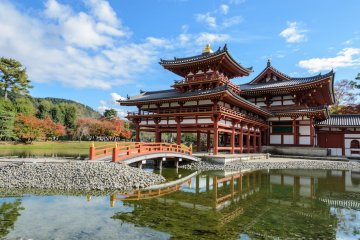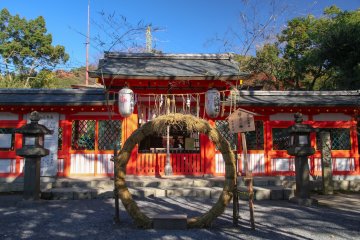
료마를 찾아라 2: 교토 데라다야
Takako Sakamoto사카모토 료마 시리즈 2: 교토 테라다야: 이곳은 사카모토 료마가 당국의 공격을 받은 곳이다. 그의 아내 오료가 다가오는 위험을 그에게 알리기 위해 욕조에서 벌거벗고 뛰어, 그를 구했다!

The Nintendo Museum in Uji City, Kyoto, offers a rare chance to explore the full legacy of one of Japan’s most influential entertainment companies. Whether you're a lifelong fan of Mario, Zelda, Pokémon, and other beloved Nintendo franchises or simply curious about how gaming has evolved over the years, this museum offers a hands-on look into the creative history behind it all.
Housed in the former Nintendo Uji Ogura Plant, the museum has been thoughtfully renovated into a modern, visitor-friendly space. The interior has been redesigned for access and accessibility while much of the entire building's original character has been preserved.
Inside, you’ll find a wide-ranging showcase of the entertainment Nintendo has created since its founding in September 1889—from traditional Hanafuda playing cards to the latest Nintendo Switch. Exhibits are arranged by era on the second floor of Exhibition Building 1, allowing visitors to follow Nintendo’s story from past to present. Across several themed zones, you can view side-by-side displays of early toys, classic handhelds, and home consoles that helped shape the gaming world. Iconic systems like the Famicom (NES), Game Boy, and Nintendo 64 are on display in excellent condition. Each exhibit is accompanied by easy-to-follow visuals in both English and Japanese, along with interactive features that let you explore Nintendo’s legacy at your own pace.
Another highlight of the museum is the Unique Play Experiences area on the first floor of Exhibition Building 1. This zone features interactive exhibits that capture Nintendo’s signature blend of creativity and innovation—including games that use oversized controllers and play out on giant screens. Each visitor receives 10 digital coins upon entry, which can be used to access selected exhibits. Since each activity requires a different number of coins, you’ll need to choose carefully—adding a light strategic element to your visit, much like playing a Nintendo game itself.
After exploring the interactive exhibits, visitors looking for a more hands-on, creative experience can join the craft workshop. Here, you’ll create your own Hanafuda playing cards. Once your set is complete, you’ll also learn the rules and have a chance to play the game. This experience requires a same-day reservation and an additional fee, so be sure to plan ahead if you’d like to take part.
Ticket information
A visit to the Nintendo Museum takes about 1.5 to 2 hours, and you’ll need to plan ahead as same-day admission isn’t available at the moment. Tickets are offered through a lottery system, and you can apply up to three months before your visit using a free Nintendo Account. If your entry gets selected, make sure to pay by the 7th of the following month using a credit card. You’ll get an email with the results, but you can also check the ticketing site. Further, your QR code ticket will be ready to download from 2pm the day before your visit.
On the day itself, don’t forget to bring your QR code and a valid ID. If you’re not a Japanese national, your passport is required. Once your code is scanned and you pass through security, you’ll get your official play ticket. If you bought tickets for friends or family, you can assign them their own QR codes too, as long as they have Nintendo Accounts.
The ticketing system is a bit of a process, but the visit offers a fun and nostalgic dive into Nintendo’s world—something many fans find well worth the effort.
The Nintendo Museum is easily accessible by train, located just a 5-minute walk from the East Exit of Ogura Station on the Kintetsu Railway Kyoto Line. It's also an 8-minute walk from the North Exit of JR Ogura Station on the JR Nara Line and about 22 minutes on foot from JR Uji Station.
Please take note that the museum doesn't offer parking spaces for cars, motorcycles, bicycles, and other types of personal vehicles.

사카모토 료마 시리즈 2: 교토 테라다야: 이곳은 사카모토 료마가 당국의 공격을 받은 곳이다. 그의 아내 오료가 다가오는 위험을 그에게 알리기 위해 욕조에서 벌거벗고 뛰어, 그를 구했다!

The Byodoin Temple in the city of Uji near Kyoto adorns the reverse of the Japanese 10 yen coin and is best known for its distinctive “phoenix hall”. The original building was built in 998 as a nobleman's villa and later by a member of the then Influential Fujiwara clans acquired and converted into a temple. Over the centuries the temple complex has been expanded and expanded, among other things, by the phoenix hall, inside of which there is an Amida Buddha statue and which thus forms the heart of the temple complex. Even if its official name is Amida Hall because of this statue, it is mainly referred to as the Phoenix Hall because of the representations of the Chinese firebird on the roof. The Byodo-in Temple has been a UNESCO World Heritage Site since 1994 and is a popular tourist destination because of its special architecture and the surrounding garden. Visitors can also admire the interior of the hall on a guided tour.

Located in Uji, the city renowned for green tea, Ujigami shrine is Japan’s oldest existing shrine. Among the country’s thousands of shrines, Ujigami shrine was one of the first — allegedly built during the year 1060. Although the shrine is rather off the beaten track, its convenient location makes it easy to combine visits with nearby Byodo-in Temple and Uji-gawa Shrine. Ujigami-jinja’s grounds are quiet and serene, located away from the bustling tourist attractions in central Kyoto. It was originally built to honor Emperor Ojin and his sons, after one of the princes committed suicide in a selfless effort to solve the dispute over imperial succession. Now, Ujigami shrine also serves as the guardian shrine for Byodo-in Temple. Visitors to Ujigami-jinja will also notice the abundance of rabbit motifs. The puzzling presence of rabbits is related to a myth about a divine rabbit that guided the lost prince back to town. Since then, the rabbit has been honored in the form of figurines, omikuji and more in the city of Uji. The temple’s springwater is said to have special qualities, making it the best choice for use in traditional tea ceremonies — rated to be among the 'Seven best waters of Uji'. Its main Honden building is also believed to be the oldest remaining example of nagare-zukuri-style architecture. Being host to such historically significant sites, it is no wonder that Ujigami-jinja was designated a UNESCO World Heritage Site in 1994.

Ōbaku-san Manpuku-ji is a temple located in Uji, Kyoto. It is the head temple of the Japanese Ōbaku Zen sect, named after Wanfu Temple in Fujian, China. The mountain is likewise named after Mount Huangbo, where the Chinese temple is situated. [Wikipedia]